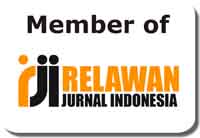Modern Standard Arabic and Yemeni Arabic Cognate: A Contrastive Study
Abstract
This study aims to investigate identical word pairs, word couples that have a phonemic correspondence, and the sound shift in phonological differences, sound variation, sound addition, and lenition. The study uses empirical data collected from 2 Yemeni college students who studied in Indonesia. Two hundred seven of Swadesh's basic vocabulary was used as the standard procedure for collecting data. The results indicated the relationship between form and meaning as a whole, a different pattern. Specifically, the three dimensions - cognate, phonemic correspondence, and a pair of words contain a different pattern, sound-change, phonological, and morpheme contrast in Modern Arabic Standard, Sana’a Yemeni Arabic (YEMS), Dhamar Yemeni Arabic (YEMD). The other sound change in the form of metathesis exposes that there are six rules: five kinds of word syllable systems and dissimilation, three forms of sound addition, and four types of sound loss. This study focuses on sound correspondence in three Arabic languages that influence more variations of Arabic. MSA, YEMS, and YEMD represent a case where two distinct language varieties exist in Yemen. It is anticipated that the findings of this study will help college students and lecturers to understand a phenomenon in Arabic-speaking communities and the significant impact it has on arranging Arabic teaching materials. The value of this research work is evident from the fact that the Arabic language teaching model has neglected the teaching of Arabic variation even though they are essential.
Keywords
Full Text:
PDFReferences
Abolohom, A., Omar, N., Pais, S., & Cordeiro, J. (2021). A Comparative Study of Linguistic and Computational Features Based on a Machine Learning for Arabic Anaphora Resolution. Procedia CIRP, 189(2019), 37–47. https://doi.org/10.1016/j.procs.2021.05.068
Abu Farha, I., & Magdy, W. (2021). A comparative study of effective approaches for Arabic sentiment analysis. Information Processing and Management, 58(2), 1–26. https://doi.org/10.1016/j.ipm.2020.102438
Al-Fatimi, M. (2019). Ethnobotanical survey of medicinal plants in central Abyan governorate, Yemen. Journal of Ethnopharmacology, 241(111973), 1–24. https://doi.org/10.1016/j.jep.2019.111973
Al-huri, I. (1997). English Literature and Language Review Arabic Language : Historic and Sociolinguistic Characteristics. 1(4), 28–36.
Al-Saqqaf, A. H. (2006). The linguistics of loanwords in Hadramī Arabic. International Journal of Bilingual Education and Bilingualism, 9(1), 75–93. https://doi.org/10.1080/13670050608668631
Alkhormi, A. H., Alshahrani, N. Z., & Mahmood, S. E. (2021). Khat chewing leads to increase in glycaemic parameters in patients with type 2 diabetes mellitus in Jazan region, Saudi Arabia and Yemen. Diabetes and Metabolic Syndrome: Clinical Research and Reviews, 15(2), 565–568. https://doi.org/10.1016/j.dsx.2021.02.035
Almansoob, N. T., Alrefaee, Y., & Patil, K. . (2019). A Cross-cultural Study of The Speech Act of Compliments in American English and Yemeni Arabic. Langkawi: Journal of The Association for Arabic and English, 5(1), 1. https://doi.org/10.31332/lkw.v5i1.1271
AlMunifi, A. A., & Aleryani, A. Y. (2021). Internal efficiency of Higher education system in armed conflict-affected countries-Yemen case. International Journal of Educational Development, 83(March), 102394. https://doi.org/10.1016/j.ijedudev.2021.102394
Alquhali, S. A. M., Gajendra, P., Bajiri, M. E. S., & Ageed, H. O. A. H. (2021). Syllabification nature in Bedouin-North Yemeni Arabic dialects (Bed-NYAD). Linguistics and Culture Review, 6(August), 102–119. https://doi.org/10.21744/lingcure.v6ns2.1904
Alrubaidi, M., Alhaddad, M. S., Al-Safi, S. I. H., Alhammadi, S. A., Yahya, A. S., & Abadel, A. A. (2021). Assessment of seismic hazards in Yemen. Heliyon, 7(12), 1–22. https://doi.org/10.1016/j.heliyon.2021.e08520
Anttila, R. (1989). Historical and comparative linguistics. In E.F. Konrad Koerner University of Ottawa (Ed.), John Benjamins Publishing Company. John Benjamins Publishing Company. https://doi.org/10.2307/414628
Ashby, P. (2021). The International Phonetic Alphabet. In Speech Sounds (pp. 71–76). https://doi.org/10.4324/9780203137437-14
Creswell, J. W. (2015). Research Design Qualitative Quantitative and Mixed Methods Approaches. In The British Journal of Psychiatry (First Edti, Vol. 111, Issue 479). Sage. https://doi.org/10.1192/bjp.111.479.1009-a
Crowley, T., & Bowern, C. (2010). An Introduction to Historical Linguistics (Fourth). Oxford. https://global.oup.com/academic/product/an-introduction-to-historical-linguistics-9780195365542?cc=us〈=en&
Díez, A. I. (2021). A typological analysis of cognate infinitives in Lebanese Arabic based on comparative Semitic evidence. Languages, 6(4). https://doi.org/10.3390/languages6040183
Elashhab, S. (2018). Epenthesis And Syncope in Some Arabic Dialects. International Journal of Humanities and Social Science Invention (IJHSSI), 7(01), 1–11.
Ellis, R. (1994). The Study of Second Language Acquisition (Oxford Applied Linguistics) -Oxford University Press, USA (1994).pdf. Oxford University Press. https://www.pdfdrive.com/the-study-of-second-language-acquisition-oxford-applied-linguistics-e162210420.html
Fromkin, V., Rodman, R., & Hyams, N. (2011). An Introduction to Language (9th edition - International Edition). In Joan M. Flaherty (Ed.), Wadsworth (Nine Editi). Wadsworth Cengage Learning.
Ghlamallah, E., Alexakis, C., Dowling, M., & Piepenbrink, A. (2021). The topics of Islamic economics and finance research. International Review of Economics and Finance, 75(March), 145–160. https://doi.org/10.1016/j.iref.2021.04.006
Hamed, M. Ben, Barkat-Defradas, M., & Hamdi-Sultan, R. (2015). The evolution of Arabic(s): Making the Idiom speak for the Deme. International Journal of Modern Anthropology, 1(8), 94. https://doi.org/10.4314/ijma.v1i8.5
Henrich, H. H. (2009). Language History, Language Change, and Language Relationship (W. Bisang (ed.)). Mouton de Gruyter.
Hussein, A., Watanabe, S., & Ali, A. (2022). Arabic speech recognition by end-to-end, modular systems and human. Computer Speech and Language, 71(August). https://doi.org/10.1016/j.csl.2021.101272
Kassim, S. (2020). The impact of protective psychosocial factors on khat chewing among male medical and dental future health-care providers in Yemen. Journal of Dental Sciences, 15(4), 451–456. https://doi.org/10.1016/j.jds.2019.08.009
Keraf, G. (1990). Linguistik Bandingan Tipologis. Gramedia.
Khitam, A. K. (2019). Phonological Dimension of the Arabic Words: the Intimate Relation Between Sound and Meaning in the Arabic Words. Arabi : Journal of Arabic Studies, 4(1), 1. https://doi.org/10.24865/ajas.v4i1.147
Magidow, A. (2021). The old and the new: Considerations in arabic historical dialectology. Languages, 6(4). https://doi.org/10.3390/languages6040163
Nasser, A., Bin-hady, W. R. A., & Thabit, S. (2020). A Study of Yemeni EFL Instructors’ Perceptions on The Role of ICTs in Developing Students’ Communicative. Indonesian Journal of Learning and Instruction, 3(2), 79–90.
Nur, T. (2016). Analisis Kontrastif Dalam Studi Bahasa. Arabi : Journal of Arabic Studies, 1(2), 64. https://doi.org/10.24865/ajas.v1i2.11
Ordan, N., Hershberg, N., & Shlesinger, M. (2010). Translational conflicts between cognate languages: Arabic into Hebrew as case in point. Corpus Linguistics and Linguistic Theory, 6(2), 217–239. https://doi.org/10.1515/CLLT.2010.008
Palimaru, A. I., Dong, L., Brown, R. A., D’Amico, E. J., Dickerson, D. L., Johnson, C. L., & Troxel, W. M. (2022). Mental health, family functioning, and sleep in cultural context among American Indian/Alaska Native urban youth: A mixed methods analysis. Social Science and Medicine, 292(October 2021), 114582. https://doi.org/10.1016/j.socscimed.2021.114582
Runge, C. F., & Graham, L. (2020). Viewpoint: Hunger as a weapon of war: Hitler’s Hunger Plan, Native American resettlement and starvation in Yemen. Food Policy, 92(October 2019), 101835. https://doi.org/10.1016/j.foodpol.2020.101835
Sellami-Baklouti, A. (2021). Transitivity-ergativity perspectives on causation in legal texts: A contrastive study of Arabic and English website terms of service. Lingua, 261, 102782. https://doi.org/10.1016/j.lingua.2019.102782
Stewart, D. J. (2014). Cognate and analogical curses in Moroccan Arabic: A comparative study of arabic speech genres. Arabica, 61(6), 697–745. https://doi.org/10.1163/15700585-12341320
Uddin, G. S., Arreola Hernandez, J., Labidi, C., Troster, V., & Yoon, S. M. (2019). The impact of financial and economic factors on Islamic mutual fund performance: Evidence from multiple fund categories. Journal of Multinational Financial Management, 52–53(100607), 100607. https://doi.org/10.1016/j.mulfin.2019.100607
Watson, J. C. (2006). Yemen: Language Situation. Encyclopedia of Language & Linguistics, 1988, 729–730. https://doi.org/10.1016/b0-08-044854-2/01847-2
Watson, J. C. (2011). South Arabian and Yemeni Dialects. Salford Working Papers in Linguistics and Applied Linguistics, 1, 27–40. http://usir.salford.ac.uk/17631/
Watson, J. C. (2011). Arabic dialects (general article). The Semitic Languages: An International Handbook, December 2011, 851–896. https://doi.org/10.1515/9783110251586.851
Younes, M. (2015). The Integrated Approach to Arabic Instruction. In Multicultural Perspectives (First Edit, Vol. 18, Issue 1). Routledge. https://doi.org/10.1080/15210960.2016.1125746
Yule, G. (2010). The Study of Language (10th ed.). Cambridge University Press.
Zang, S. (2021). Cross-Cultural communication of language learning social software based on FPGA and transfer learning. Microprocessors and Microsystems, 81(December 2020), 103768. https://doi.org/10.1016/j.micpro.2020.103768
DOI: http://dx.doi.org/10.31332/lkw.v0i0.4240
Copyright (c) 2022 Darsita Suparno, M. Azwar, Abdulkhaleq Al-Rawafi, Minatur Rokhim, Nofry Angga, Aqidatul Izzah Chairul

This work is licensed under a Creative Commons Attribution-ShareAlike 4.0 International License.
Langkawi: Journal of The Association for Arabic and English indexed by:


















.png)
.png)

.png)
2.png)








